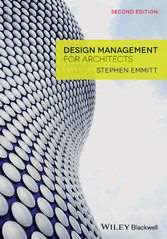
Design Management for Architects
von: Stephen Emmitt
Wiley-Blackwell, 2014
ISBN: 9781118394458
Sprache: Englisch
304 Seiten, Download: 930 KB
Format: EPUB, auch als Online-Lesen
Chapter Two
The Business of Projects
Architectural practices are project-driven organisations. They are dependent on the sponsors of construction projects and in many cases the major contractors for their existence and profitability: no projects, no business. In a competitive marketplace architectural practices must be able to articulate the value of their designs and clearly set out how they are going to manage risk, costs and programmes and deliver a high quality service. It is the individual projects that provide a vehicle to practise design and hence realise architecture. The primary goal is to deliver maximum value for the customer, while making a reasonable profit on the resources invested. To do this in a consistent and effective way requires the implementation of quality management and an appropriate philosophy for minimising waste and maximising value to the business. This will be achieved through a consistent approach to design management within the office and an appropriate level of control over design decisions at the project level. The former is in the hands of the architectural office; the latter is in the hands of the project contributors and is influenced by the type of procurement route, contracts and shared responsibilities.
Understanding projects
Architectural education is first and foremost concerned with educating architects in the art of design. As such, there is little space left within the curriculum to devote much attention to the commercial realities of projects. This tends to be learned through the act of engaging with projects in the workplace. It is here that many architects quickly come to realise that there is a significant difference in understanding between the designers, clients and contractors. This stems from different perspectives:
- From the client’s perspective the project is a means to an end. Designers and contractors are employed to fulfil a need.
- The focus of the designers is on creating design value and generating a fee.
- Contractors’ aim to deliver value to the client and return a profit on the resources invested.
These are culturally different worlds, brought together temporarily through a project. In essence a project is the harmonious weaving together of people, materials, technologies and place. Being able to understand and hence respond to different perspectives, needs and wants will be influential in helping the architectural practice to deliver a quality service. The role of the design manager is to analyse the project context and respond to the project deliverables in a timely and consistent manner.
Project deliverables
Project management literature has identified three project deliverables that compete for attention and hence place a degree of tension in the system. These are cost, time and quality, represented in Figure 2.1. The theory is that placing emphasis on one project deliverable, for example time, can cause the other deliverables to suffer. This would equate to fast project, high cost and low quality. Of course, with adequate forward planning and excellent design and realisation teams, it is possible to deliver high quality buildings quickly and at reasonable cost. These three aspects are explored a little further, together with the addition of a fourth parameter: design.
- Quality. A lot of work has been done in manufacturing to ensure processes are defect free, thus ensuring a quality product every time. Artisans would guarantee a similar level of assurance through application of their craft. Clients will want to see evidence of quality control and quality management procedures. The quality of the finished artefact will be partly subjective, but mainly objective when analysed against the client brief.
Figure 2.1 Project deliverables.
- Time. Time is a precious resource that has an economic value. For commercial enterprises the sooner clients receive their building the greater the financial return. Building designers and builders able to minimise the amount of time required to assemble a building, from inception to occupancy by the client, have a competitive advantage over those who cannot, which is a service many clients are willing to pay a premium for. Similarly, architects that consistently deliver designs and buildings on time will have a competitive advantage over those who cannot.
- Economy. Financial control of individual projects is paramount in the minds of clients, who demand cost certainty, and is a natural focus of project management. Although financial control and monitoring is important, decisions should be taken with due consideration for the building design and the performance of the building over its entire life cycle. Design managers will contribute to project cost certainty through management of the design decisions made and encoded in project/contract documentation.
- Design. Design is often the missing factor in the mind of the project manager; at best implicit in quality. It is the design manager who has to champion the design – promoting the value of design to all project stakeholders and defending the design team and design decisions.
These parameters need to be viewed in terms of the prevailing legislation, environmental sustainability and ethical business.
Quality
Quality is a negotiated, and often subjective, project parameter that is determined by budget, time, the decisions made, and the actions taken during the project. Trying to define quality objectively is a real challenge because of the complex nature of building and the large number of parties who have a stake in achieving quality and different perspectives of quality. Design managers will be concerned with the quality of the product and the quality of the service provided.
Quality of the product is usually the quality of the drawings and other supporting design documentation. Indirectly this also relates to the quality of the finished building, although the build quality is largely outside the control of architects in the majority of contractual arrangements. Quality of the service provided will mostly relate to the client’s perceived level of service. This will be coloured by the interactions with the client throughout the life of the project.
Quality control
Quality control (QC) is a managerial tool that ensures work conforms to predetermined performance specifications and adherence to current codes, standards and regulations. For professional service firms QC is concerned with checking project documentation against the agreed standards. Checking drawings, written specifications and associated documentation before issue, and checking other consultants’ documentation for consistency with the overall design concept and project parameters, will help to control the quality of the information produced. This, in turn, will help to reduce the number of requests for information during the construction process and may go some way in helping to reduce the number of requests for design changes.
Quality assurance
Quality assurance (QA) is a formally implemented management system that is certified and constantly monitored by an independent body, such as the British Standard Institution (BSI), to ensure compliance with the ISO 9000 series. This is a highly effective managerial system that can bring significant benefits to an architectural practice. The design manager’s role is to ensure that procedures are simple and enhance the effectiveness of work within the project and within projects.
Total quality management
Provision of a quality service is fundamental to the competitiveness of a modern organisation. Attempting constantly to please the client or customer is central to the total quality management (TQM) philosophy. It is a people-focused management concept that aims at continual improvement and greater integration through a focus on client satisfaction – essentially a soft management tool involving pride in one’s work and the constant desire to improve upon past success. This is a philosophy ideally suited to professional service firms.
Time control
One of the peculiarities of construction projects is the differences in approaches to programming between design and construction. Designers are familiar with programmes that relate to tasks and activities. These, often simple, programmes reflect the iterative nature of design and design activities that are not easy to break down into time related elements. Hence programmes identify key dates and activities, while also allowing some latitude to allow for tasks being completed faster or slower than anticipated. In the design process uncertainty is high and many factors are not known. It is only by designing that the solution becomes more detailed and the uncertainty reduces, and hence programmes become more concrete as the design evolves. In contrast, constructors and project managers are more familiar with programmes that specify deliverables (milestones) in considerable detail. At this stage in the project certainty is high. The design is complete (or substantially complete) and it is a relatively straightforward task to break the project down into clearly defined work packages. These work packages can then be costed and accurate timescales and interdependencies allocated to each package. The resulting construction programmes are usually highly complex Gantt charts that may have little meaning to designers. It is these differences in the iterative nature of design and the linear nature of construction that can lead to clashes between the design team’s programme and that of the...










